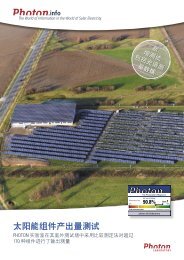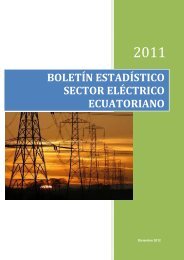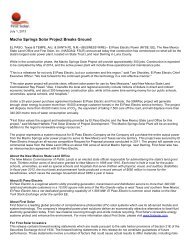INTRODUCTORY SPECIAL INTRODUCTORY ... - PHOTON Info
INTRODUCTORY SPECIAL INTRODUCTORY ... - PHOTON Info
INTRODUCTORY SPECIAL INTRODUCTORY ... - PHOTON Info
Create successful ePaper yourself
Turn your PDF publications into a flip-book with our unique Google optimized e-Paper software.
12<br />
Readers‘ letters<br />
So why are so few homes outfitted<br />
with solar generation capability? For a<br />
long time the answer has been: cost.<br />
The key to cost reduction is innovation.<br />
Most often innovation comes from<br />
smaller organizations with a close-knit<br />
and dedicated employee base that share<br />
a more common goal/philosophy than<br />
a large organization. Red-tape has put<br />
an end to brilliant innovation more<br />
times in history then I’d care to count.<br />
I suggest you include a »spotlight on in-<br />
novation« section in your magazine to<br />
focus on individuals and small busi-<br />
nesses that are innovating, rather than<br />
the products of huge corporate research<br />
budgets and projects. This personalizes<br />
the industry in a way that will get the<br />
target audience (those end-customers<br />
in the US interested in building a PV<br />
system) excited about the technology.<br />
This will help people understand that<br />
solar power is NOT a large corporate<br />
gimmick designed to take their money,<br />
or a political ploy catering to recent<br />
global climate change realizations.<br />
There are multitudes of regular, grass-<br />
roots enthusiasts pursuing innovation<br />
and who believe in the future of this<br />
technology’s benefit to mankind.<br />
Dustin Charamut<br />
Mechanical Design / Systems R&D, Aerospec Inc.<br />
I hope you are planning to track solar<br />
stocks as an index and individual securi-<br />
ties, as has been the case in <strong>PHOTON</strong><br />
International.<br />
Jeff Shaddock<br />
Project Manager, MA Properties<br />
I think something that might be<br />
valuable is to have a map of the states<br />
outlining some key stats about the<br />
current incentives within a state – like<br />
a cheat sheet, if you will. Then, when<br />
something changes in that state, it<br />
will be highlighted, so that people no-<br />
tice. I think one of the biggest areas of<br />
confusion (especially for people com-<br />
ing from other countries that have a<br />
unified solar incentive program) is re-<br />
membering which state has what in-<br />
centive and if that knowledge is cur-<br />
rent. Maybe you can even make a<br />
something that people can tear out of<br />
the magazine each month and post on<br />
their bulletin board.<br />
Lee Johnson<br />
Vice President, Stellaris Corporation<br />
If you can combine PV-specific news<br />
with up-to-date hands-on installation<br />
and regulatory information as well as<br />
national and global political PV news,<br />
you will have a hit.<br />
Mark McCain<br />
Austin, TX<br />
Case studies always garner interest<br />
from readers. I think people want to<br />
know about actual installations, from<br />
the folks who went through the struggle<br />
themselves. Especially in a relatively<br />
new and exploding marketplace, it’s<br />
critical for people to be able to read about<br />
the challenges they may encounter, and<br />
innovative ways that others have over-<br />
come them.<br />
Joanne Lowy<br />
Director of Marketing, AlsoEnergy<br />
If I was going to create a magazine<br />
about solar I would really like to see a<br />
strong emphasis on solar from start to<br />
finish. Whether it’s a story related to the<br />
first silicon crystal forming in a factory,<br />
a piece of legislation in congress, or a<br />
story about the last bolt being put in<br />
place on a solar system. My description<br />
F1 Online digitale Bildagentur GmbH<br />
is fairly vague, but I think you probably<br />
understand what I’m getting at.<br />
I would also like to see »<strong>PHOTON</strong>«<br />
add open editorials, along with a power-<br />
fully matched internet based networking<br />
site. The web site would be a great source<br />
for documenting advances. It could be a<br />
great forum for scientists, government ad-<br />
vocates, contractors and many others to<br />
voice their opinions and ideas. I also think<br />
it would be great, if some of the better fo-<br />
rums and their highlights could be posted<br />
in the magazine. That would bring further<br />
attention to these topics and cause others<br />
to voice their thoughts, in editorials, on-<br />
line, or publicly. I think it would be really<br />
neat, if both (magazine and web content)<br />
could inform people about social meet-<br />
ings in the real world. Whether this meet-<br />
ing is at a local bar, or with their congress-<br />
man. All of these different ideas for how<br />
<strong>PHOTON</strong> could connect people would be<br />
a great way to promote solar and raise in-<br />
terest in the topic, rather than just being a<br />
magazine they read once to pass the time.<br />
I hope these ideas have been useful.<br />
Chase Drum<br />
Competitive Solar<br />
This year we installed a 3.7 kW rooftop<br />
solar array – everything’s working per-<br />
fectly. It’s fun watching the meter run<br />
backwards. The problem we’d like to see<br />
your magazine address is called »TRue-<br />
Up,« a phenomenon in which PG&E takes<br />
the excess electricity we generate and feed<br />
into the gird, and then keeps a record for<br />
each month that shows a progressive in-<br />
crease in the amount of power we »sell«<br />
to them. However, at the end of each cal-<br />
endar year, if we’ve generated more pow-<br />
er than we’ve used, rather than send us a<br />
check for the excess power, or giving us a<br />
credit for our natural gas usage, PG&E just<br />
starts the meter at zero, effectively steal-<br />
ing any extra electricity we’ve generated<br />
beyond consumption. If we use MORE<br />
power than we generate, PG&E would bill<br />
us for the extra power. We don’t think<br />
this is fair, and apparently it’s not the<br />
same in all areas of the US.<br />
Jack Reineck<br />
reineckandreineck.com<br />
November 2009

















